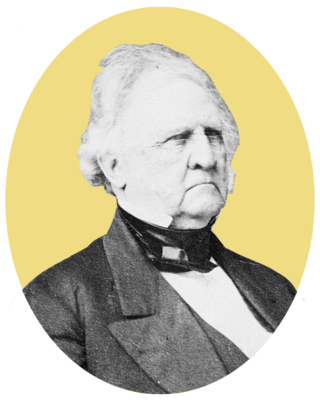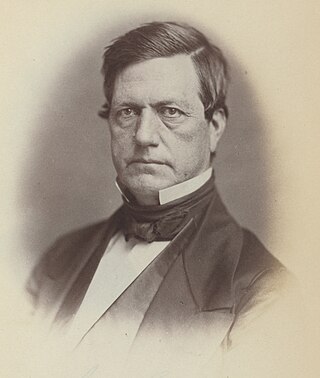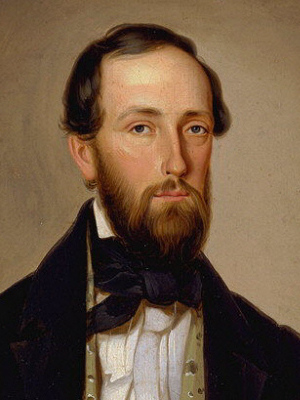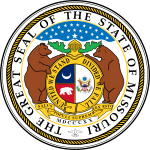
Presidential elections were held in the United States on November 2, 1852. Democratic nominee Franklin Pierce defeated Whig nominee General Winfield Scott.

The 1852 Whig National Convention was a presidential nominating convention held from June 16 to June 21, in Baltimore, Maryland. It nominated the Whig Party's candidates for president and vice president in the 1852 election. The convention selected General-in-Chief Winfield Scott for president and U.S. secretary of the navy William A. Graham for vice president.

John Bullock Clark Sr. was a militia officer and politician who served as a member of the United States Congress and Confederate Congress. Born in Kentucky, Clark moved with his family to Missouri in 1818 and studied law. He opened a legal practice in Fayette, Missouri, in 1824. He held several positions in the local government in the 1820s and 1830s. Clark was also involved in the state militia, serving as a colonel in the Black Hawk War in 1832 and eventually rising to the rank of major general. In 1838, during the Missouri Mormon War, Clark was the recipient of Governor Lilburn Boggs's infamous Mormon Extermination Order, and was involved in the ending stages of the conflict. He was the Whig candidate in the 1840 Missouri gubernatorial election. Clark was accused of conspiring to commit electoral fraud in the election and as a result almost fought a duel with Claiborne Fox Jackson, later a Governor of Missouri.

The 1852 New York state election was held on November 2, 1852, to elect the governor, the lieutenant governor, a Canal Commissioner and an Inspector of State Prisons, as well as all members of the New York State Assembly.

The 1846 New York state election was held on November 3, 1846, to elect the governor, the lieutenant governor and two Canal Commissioners, as well as all members of the New York State Assembly and eight members of the New York State Senate.

The 1852–53 United States Senate elections were held on various dates in various states, coinciding with the 1852 presidential election. As these U.S. Senate elections were prior to the ratification of the Seventeenth Amendment in 1913, senators were chosen by state legislatures. Senators were elected over a wide range of time throughout 1852 and 1853, and a seat may have been filled months late or remained vacant due to legislative deadlock. In these elections, terms were up for the senators in Class 2.

The 1844 Missouri gubernatorial election was held on August 5, 1844, Missouri Secretary of State John C. Edwards, the Democratic nominee, defeated Whig candidate Charles H. Allen.

The 1848 Missouri gubernatorial election was held on August 7, 1848, the Democratic nominee, Austin Augustus King, defeated Whig candidate James S. Rollins.

The 1852 United States House of Representatives election in Florida was held on Tuesday, October 5, 1852, to elect the single United States Representative from the state of Florida, one from the state's single at-large congressional district, to represent Florida in the 33rd Congress. The election coincided with the elections of other offices, including the presidential election, the gubernatorial election, and various state and local elections.

The 1856 United States House of Representatives election in Florida was held on Monday, October 6, 1856 to elect the single United States Representative from the state of Florida, one from the state's single at-large congressional district, to represent Florida in the 35th Congress. The election coincided with the elections of other offices, including the presidential election, the senatorial election, the gubernatorial election, and various state and local elections.

The 1860 United States elections elected the members of the 37th United States Congress. The election marked the start of the Third Party System and precipitated the Civil War. The Republican Party won control of the presidency and both houses of Congress, making it the fifth party to accomplish such a feat. The election is widely considered to be a realigning election.

The 1853 New Jersey gubernatorial election was held on November 1, 1853. Democratic nominee Rodman M. Price defeated Whig nominee Joel Haywood with 52.60% of the vote.

The 1852 United States presidential election in Missouri took place on November 2, 1852, as part of the 1852 United States presidential election. Voters chose nine representatives, or electors to the Electoral College, who voted for President and Vice President.

The 1852 Michigan gubernatorial election was held on November 2, 1852. Incumbent Democrat Robert McClelland defeated Whig nominee Zachariah Chandler with 51.07% of the vote.

The 1852 Connecticut gubernatorial election was held on April 5, 1852. Incumbent governor and Democratic Party nominee Thomas H. Seymour defeated incumbent Lieutenant Governor and Whig nominee Green Kendrick with 50.39% of the vote.

The 1852–53 Massachusetts gubernatorial election consisted of an initial popular vote held on November 8, 1852, followed by a legislative vote conducted on January 12, 1853, which elected Whig Party nominee John H. Clifford. The ultimate task of electing the governor had been placed before the Massachusetts General Court because no candidate received the majority of the vote required for a candidate to be elected through the popular election.

The 1852 Florida gubernatorial election was held on October 4, 1852. Democratic nominee James E. Broome defeated the Whig nominee George T. Ward.

The 1852 Illinois lieutenant gubernatorial election was held on 2 November 1852 in order to elect the lieutenant governor of Illinois. Democratic nominee and former member of the Illinois House of Representatives Gustav Koerner defeated Whig nominee and former member of the Illinois Senate James L. D. Morrison and Free Soil nominee Philo Carpenter.

The 1836 Missouri lieutenant gubernatorial election was held on 1 August 1836 in order to elect the lieutenant governor of Missouri. Democratic nominee and incumbent member of the Missouri Senate Franklin Cannon defeated Whig nominee James Jones.






















